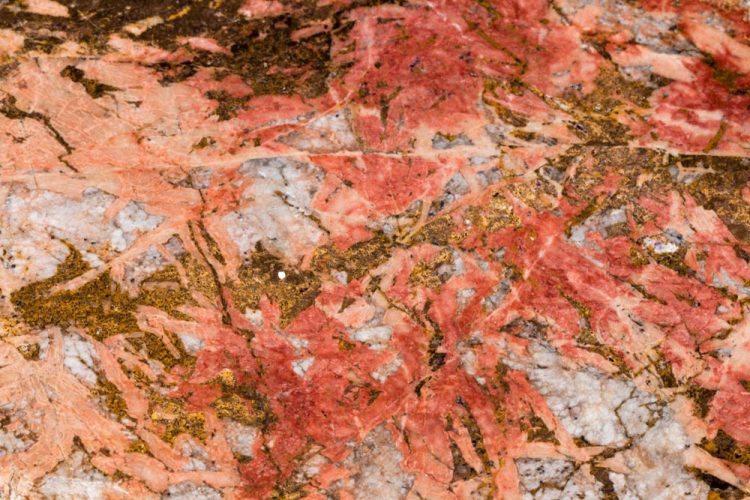Where is the greatest risk to our mineral resource supplies?

Bastnaesite (the reddish parts) in Carbonatite. Bastnaesite is an important ore for rare earth elements, one of the mineral commodities identified as most at-risk of supply disruption by the USGS in a new methodology. Credit: Scott Horvath, USGS
Policymakers and the U.S. manufacturing sector now have a powerful tool to help them identify which mineral commodities they rely on that are most at risk to supply disruptions, thanks to a new methodology by the U.S. Geological Survey and its partners.
“This methodology is an important part of how we're meeting our goals in the President Trump's Strategy to ensure a reliable supply of critical minerals,” said USGS director Jim Reilly. “It provides information supporting American manufacturers' planning and sound supply-chain management decisions.”
The methodology evaluated the global supply of and U.S. demand for 52 mineral commodities for the years 2007 to 2016. It identified 23 mineral commodities, including some rare earth elements, cobalt, niobium and tungsten, as posing the greatest supply risk for the U.S. manufacturing sector. These commodities are vital for mobile devices, renewable energy, aerospace and defense applications, among others.
“Manufacturers of new and emerging technologies depend on mineral commodities that are currently sourced largely from other countries,” said USGS scientist Nedal Nassar, lead author of the methodology. “It's important to understand which commodities pose the greatest risks for which industries within the manufacturing sector.”
The supply risk of mineral commodities to U.S. manufacturers is greatest under the following three circumstances: U.S. manufacturers rely primarily on foreign countries for the commodities, the countries in question might be unable or unwilling to continue to supply U.S. manufacturers with the minerals; and U.S. manufacturers are less able to handle a price shock or from a disruption in supply.
“Supply chains can be interrupted for any number of reasons,” said Nassar. “International trade tensions and conflict are well-known reasons, but there are many other possibilities. Disease outbreaks, natural disasters, and even domestic civil strife can affect a country's mineral industry and its ability to export mineral commodities to the U.S.”
Risk is not set in stone; it changes based on global market conditions that are specific to each individual mineral commodity and to the industries that use them. However, the analysis indicates that risk typically does not change drastically over short periods, but instead remains relatively constant or changes steadily.
“One thing that struck us as we were evaluating the results was how consistent the mineral commodities with the highest risk of supply disruption have been over the past decade,” said Nassar. “This is important for policymakers and industries whose plans extend beyond year-to-year changes.”
For instance, between 2007 and 2016, the risk for rare earth elements peaked in 2011 and 2012 when China halted exports during a dispute with Japan. However, the supply of rare earth elements consistently remained among the highest risk commodities throughout the entire study period.
In 2019, the U.S. Department of Commerce, in coordination with the Department of the Interior and other federal agencies, published the interagency report entitled “A Federal Strategy to Ensure a Reliable Supply of Critical Minerals,” in response to President Trump's Executive Order 13817. Among other things, the strategy commits the U.S. Department of the Interior to improve the geophysical, geologic, and topographic mapping of the U.S.; make the resulting data and metadata electronically accessible; support private mineral exploration of critical minerals; make recommendations to streamline permitting and review processes enhancing access to critical mineral resources.
###
The methodology is entitled “Evaluating the Mineral Commodity Supply Risk of the U.S. Manufacturing Sector,” and is published in Science Advances. The USGS National Minerals Information Center is the source of supply and demand data for more than 90 minerals and mineral materials essential to the U.S. economy and national security.
Media Contact
All latest news from the category: Earth Sciences
Earth Sciences (also referred to as Geosciences), which deals with basic issues surrounding our planet, plays a vital role in the area of energy and raw materials supply.
Earth Sciences comprises subjects such as geology, geography, geological informatics, paleontology, mineralogy, petrography, crystallography, geophysics, geodesy, glaciology, cartography, photogrammetry, meteorology and seismology, early-warning systems, earthquake research and polar research.
Newest articles

NASA: Mystery of life’s handedness deepens
The mystery of why life uses molecules with specific orientations has deepened with a NASA-funded discovery that RNA — a key molecule thought to have potentially held the instructions for…

What are the effects of historic lithium mining on water quality?
Study reveals low levels of common contaminants but high levels of other elements in waters associated with an abandoned lithium mine. Lithium ore and mining waste from a historic lithium…

Quantum-inspired design boosts efficiency of heat-to-electricity conversion
Rice engineers take unconventional route to improving thermophotovoltaic systems. Researchers at Rice University have found a new way to improve a key element of thermophotovoltaic (TPV) systems, which convert heat…



